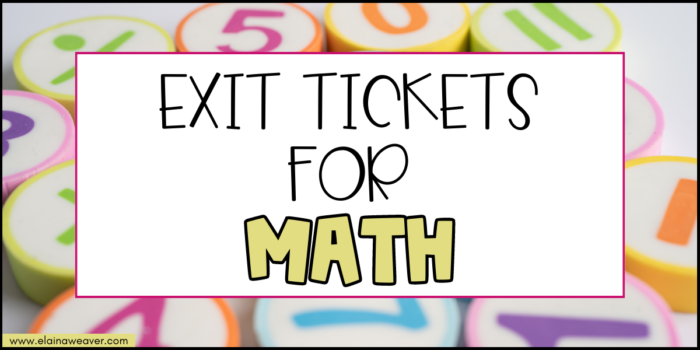Do you use exit tickets for math? Perhaps you tried before, but you struggle to be consistent with them. And does it even matter? Do they actually benefit your students or are they simply a time filler?
Those questions and thoughts are just a glimpse into the conversations happening in my DMs when I opened my Instagram stories up to questions about exit tickets.
Almost every teacher I chatted with was familiar with exit tickets, but many of them wondered how to make them work effectively in the classroom.

Exit Ticket Examples
While most teachers are familiar with exit tickets, I want to start with a few examples of exit tickets for math. I think sometimes we put ourselves in a box when it comes to exit tickets. We forget that there is not one right way to present an exit ticket.
A few exit ticket examples:
- Error Analysis Tasks
- Problem Solving Tasks – A Spiral Review
- Writing Prompts
While I love the error analysis and problem solving tasks, I think writing prompts might be my favorite form of an exit ticket because there are so many options that allow me a deep look into students’ understanding.
Asking your students about their favorite mistake provides them an opportunity to really examine their work in the class and learn from that mistake.
Giving student an opportunity to compare strategies deepens their understanding of the topic and encourages them to be open-minded.
Providing students with these opportunities to self reflect plays a big role in creating a student centered classroom.
How to use Exit Tickets in the Classroom
“I never really have time to do them, do you?”
“How to consistently use them in the classroom?”
You are deep into your lesson or activity for the day. Possibly working with a small group while other students rotate through stations. Or perhaps you are deep into a whole group discussion. Basically, class is busy and before you know it is time to dismiss class and those exit tickets are still sitting on your desk. Now there is no time to complete them.
The solution? Set yourself a timer. This has been a game changer for me. This is how I make sure I have time for exit tickets. Setting a timer on my phone ensures that I don’t get too busy and run out of time. I use a timer for almost everything in my classroom. If you want to know more about how I use timers, leave me a comment on this blog post and let me know. Perhaps I will write a blog post all about timers.

How do I stay consistent with exit tickets?
I make sure the exit tickets I use serve a purpose. I am intentional about what types of questions I ask my students with exit tickets.
Two Ways I Use Exit Tickets for Math:
- Formative Assessment – Sometimes these are graded and returned to students. Other times they are used to determined which students need remediation time.
- Synthesize the lesson – It is important to give students the chance to summarize what they’ve learned.
Another tip I have for you to help you be consistent with exit tickets is to remember you don’t have to have one every single day. I give my students an exit ticket one or two times a week. Any more than that and they start to lose their purpose and instead become busy work for both me and my students.
Exit Tickets should also be short and sweet and to the point. One or two questions is enough to provide the information you are looking for if you are intentional with those questions.
Benefits of Using Exit Tickets in the Classroom
The benefits of exit tickets have been weaved throughout this post, but I wanted to take a moment here to summarize them.
- Formative Assessment – Exit Tickets provide me with data to guide my instruction and better support my students.
- Quick Feedback for Students – Keeping exit tickets short allows me to check them quickly and return them to students to provide students with feedback.
- Closure – Exit Tickets can be a way for students to synthesize what they have learned and gain a sense of closure for the lesson.

